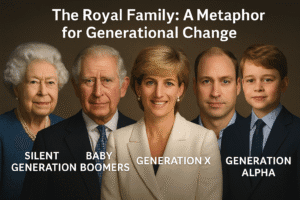Introduction
Over the past decade, the world of work has undergone a profound transformation. Organisations have become more digital, distributed, and demographically diverse. In most workplaces, four or even five generations now work side by side — from Baby Boomers (born 1942–1965) to Generation Z (born 1997–2010) and the emerging Generation Alpha. Each generation brings its own strengths, expectations, and communication styles. The challenge for leaders is not simply to manage this diversity, but to leverage it — to turn generational difference into organisational advantage. One of the most powerful ways to do this is through reverse mentoring.
What Is Reverse Mentoring?
Traditionally, mentoring has been a “top-down” process in which experienced professionals guide and develop younger colleagues. Reverse mentoring flips this centuries-old model. In reverse mentoring, younger or less senior employees act as mentors to more senior leaders, helping them gain insights into emerging technologies, workplace culture, and the lived experiences of younger generations and underrepresented groups.
As Jennifer Jordan and Michael Sorell note in Harvard Business Review (2019), “reverse mentoring not only develops younger employees — it keeps senior leaders in touch with the realities of modern organisational life.”
The Business Case
- Bridging generational divides: Encourages empathy, understanding, and communication across age cohorts.
- Driving inclusion and equity: Provides leaders with authentic insights into the experiences of younger, diverse employees (Deloitte, 2023).
- Enhancing digital literacy: Helps senior leaders keep pace with technological and cultural shifts.
- Building retention and engagement: Younger employees who feel heard and valued are significantly more likely to stay (Gallup, 2024).
- Developing leadership pipelines: Provides younger staff with confidence, exposure, and networking opportunities.
‘Reverse mentoring helps to democratise knowledge, flatten hierarchies, and accelerate cultural change.’ — CIPD, Mentoring in the Modern Workplace (2024)
How It Works
- Pairing Participants: Match mentors (younger employees) and mentees (senior leaders) based on shared interests, goals, and developmental needs. A short pre-programme questionnaire helps align expectations.
- Preparation and Training: Provide both parties with an orientation. Younger mentors may need confidence-building and communication support; senior mentees may need guidance on active listening and openness to feedback.
- Goal Setting and Structure: Each pair should define shared objectives, meeting frequency and duration (typically 4–6 sessions over six months), confidentiality boundaries, and review checkpoints.
- Facilitation and Review: A programme coordinator should monitor progress, address challenges, and gather feedback. Pilot schemes are often the most effective way to refine the process before scaling up.
Qualities of Successful Partnerships
| Effective Mentors | Effective Mentees |
| Active listeners | Open to feedback and new perspectives |
| Confident communicators | Willing to share experiences honestly |
| Curious and empathetic | Committed to personal growth |
| Respect confidentiality | Model humility and trust |
Practical Tips for Implementation
- Start small: Pilot with 5–10 pairs before wider rollout.
- Secure leadership buy-in: Endorsement from the top signals seriousness.
- Create psychological safety: Trust and confidentiality are essential.
- Evaluate outcomes: Measure shifts in engagement, inclusion, and leadership awareness.
Sample Agenda for the First Meeting
- Introductions — Share backgrounds and reasons for joining.
- Purpose — Discuss what success looks like for each participant.
- Ground Rules — Agree on confidentiality and communication style.
- Topics for Discussion — Identify 2–3 focus areas (e.g., technology, generational insights, inclusion).
- Next Steps — Confirm frequency, format, and next meeting date.
Emerging Trends (2024–2025)
- AI-assisted mentoring: Tools like MentorcliQ and Together AI now match pairs using machine learning algorithms.
- Cross-sector mentoring: Public and private sector organisations are collaborating to exchange generational insights.
- Reverse mentoring for DEI: Companies like PwC and GSK use reverse mentoring to strengthen inclusion strategies.
- Executive digital fluency: Reverse mentoring has become a key tool for upskilling boards in AI, cybersecurity, and social media literacy.
References
- CIPD (2024). Mentoring in the Modern Workplace.
- Deloitte (2023). The Multigenerational Workforce: Harnessing Diversity for Competitive Advantage.
- Gallup (2024). State of the Global Workplace Report.
- Harvard Business Review (Jordan, J., & Sorell, M.) (2019). Why Reverse Mentoring Works and How to Do It Right.
- PwC (2024). Inclusion through Connection: The Power of Reverse Mentoring.
- KPMG (2022). Inclusive Leadership and Generational Engagement Report.







